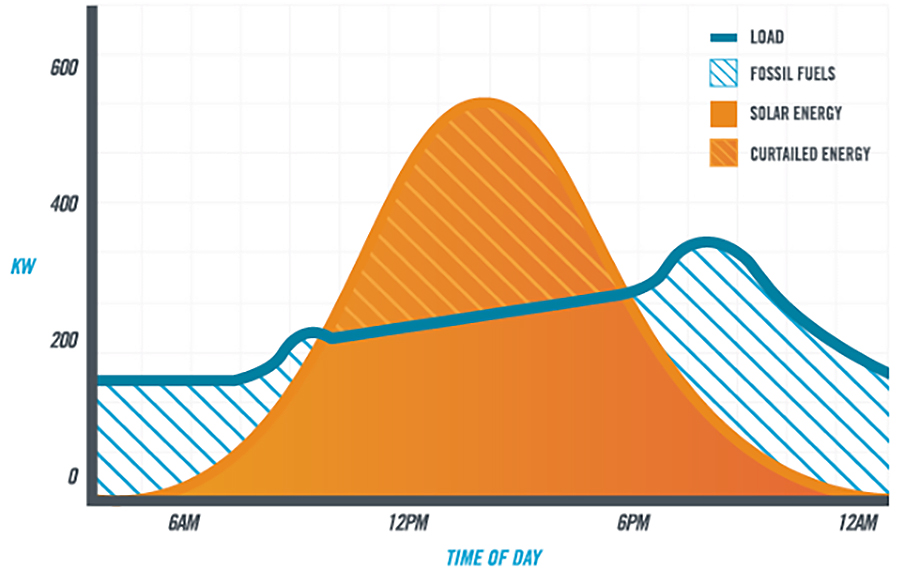California utility will try to store renewable energy in iron-flow batteries
California utility will try to store renewable energy in iron-flow batteries Freethink


A California utility company is testing iron-flow batteries for renewable energy storage
A California utility company is testing whether iron-flow batteries could be the answer to the renewable energy storage problem — a major hurdle between us and a future powered by clean energy.
The Challenge: Consistency in Renewable Energy
Renewable energy may be better for the environment, but it can’t compete with fossil fuels when it comes to consistency — you can burn natural gas anytime, but you can’t force the sun to shine or the wind to blow.
This variability is a challenge over the course of the day, since wind or solar output often peaks at different times than energy demand. This results in wasted energy when renewables are producing more than the grid needs and forces us to rely on fossil fuels to fill in the gap when they fall short.

The Status Quo: The Need for Energy Storage
To close this reliability gap — and open the door to an electric grid powered solely by renewables — we need a way to store excess renewable energy when supply is high for use when it’s low.
Batteries are the most scalable way to do this, but the type most commonly used by utility companies, lithium-ion batteries, aren’t ideal.
Those batteries are always losing a little bit of charge, which affects their efficiency, and after a while, they lose their ability to hold any charge (something you may know from owning a smartphone).
Lithium-ion batteries are also prone to overheating and catching fire, which makes them a huge safety hazard. Additionally, mining the metals needed for them is an environmentally destructive process, and the supply of those metals may not be enough to meet all of our needs.
The Alternative: Iron-Flow Batteries
Lithium-ion batteries aren’t the only option, though, and Oregon-based company ESS Inc. is on a mission to make an alternative type, called an “iron-flow battery,” the renewable energy storage solution of the future.
These use electro-chemical reactions involving two abundant, non-toxic materials — saltwater and iron — to store a charge, and they’re about as safe as batteries get. ESS says its iron-flow batteries don’t degrade over time and have an expected lifespan of 20,000 cycles (compared to 3,000 to 4,000 cycles for lithium-ion batteries).
ESS has designed two energy solutions around its iron-flow batteries: the Energy Center, a larger system ideal for utility providers, and the Energy Warehouse, a shipping container-sized system designed for easy deployment at commercial and industrial sites.
Each Energy Warehouse has a peak capacity of 500 kilowatt-hours — enough to power the average American home for about 3 weeks — while the Energy Centers are designed to be scalable to “any project size.”
Recent Developments: Iron-Flow Batteries in Action
On September 11, ESS announced that it had delivered six Energy Warehouses to the Sacramento Municipal Utility District (SMUD), which serves a population of 1.5 million people and relies on carbon-free sources to supply about 50% of its energy.
SMUD’s plan is to use this installation to learn the ins and outs of working with iron-flow batteries, which are more complex than lithium-ion ones, before scaling up to a larger installation featuring at least one Energy Center.
“SMUD is on a bold journey to eliminate all carbon emissions from our power supply by 2030 without compromising our world class reliability and rates that are consistently among the lowest in California,” said Paul Lau, CEO and general manager of SMUD.
“We’re excited to embrace cutting-edge technologies, including through our partnership with ESS, to deliver and grow long-duration energy storage,” he continued.
The Big Picture: Iron-Flow Batteries as a Solution
ESS has been delivering its batteries to customers since 2015, but if the SMUD partnership scales up as planned, it will be the biggest installation of any iron-flow battery system to date.
That means it’ll be our first opportunity to see whether they really could be the answer to the renewable energy storage problem — or if we need to keep exploring other alternatives.
We’d love to hear from you! If you have a comment about this article or if you have a tip for a future Freethink story, please email us at [email protected].
SDGs, Targets, and Indicators
| SDGs | Targets | Indicators |
|---|---|---|
| SDG 7: Affordable and Clean Energy | Target 7.1: By 2030, ensure universal access to affordable, reliable, and modern energy services | Indicator 7.1.2: Proportion of population with access to electricity |
| SDG 7: Affordable and Clean Energy | Target 7.2: By 2030, increase substantially the share of renewable energy in the global energy mix | Indicator 7.2.1: Renewable energy share in the total final energy consumption |
| SDG 7: Affordable and Clean Energy | Target 7.3: By 2030, double the global rate of improvement in energy efficiency | Indicator 7.3.1: Energy intensity measured in terms of primary energy and GDP |
| SDG 9: Industry, Innovation, and Infrastructure | Target 9.4: By 2030, upgrade infrastructure and retrofit industries to make them sustainable, with increased resource-use efficiency and greater adoption of clean and environmentally sound technologies and industrial processes | Indicator 9.4.1: CO2 emission per unit of value added in manufacturing industries and construction |
| SDG 11: Sustainable Cities and Communities | Target 11.6: By 2030, reduce the adverse per capita environmental impact of cities, including by paying special attention to air quality and municipal and other waste management | Indicator 11.6.2: Annual mean levels of fine particulate matter (e.g. PM2.5) in cities |
| SDG 13: Climate Action | Target 13.2: Integrate climate change measures into national policies, strategies, and planning | Indicator 13.2.1: Number of countries that have communicated the strengthening of institutional, systemic, and individual capacity-building to implement adaptation, mitigation, and technology transfer |
1. Which SDGs are addressed or connected to the issues highlighted in the article?
SDG 7: Affordable and Clean Energy
The article discusses the challenge of storing excess renewable energy and the need for reliable energy storage solutions to support a future powered by clean energy.
SDG 9: Industry, Innovation, and Infrastructure
The article mentions the alternative iron-flow batteries as a potential solution for renewable energy storage, highlighting their use of non-toxic materials and their expected lifespan compared to lithium-ion batteries.
SDG 11: Sustainable Cities and Communities
The article emphasizes the importance of reducing the adverse environmental impact of cities, including air quality, which can be addressed by transitioning to clean energy sources.
SDG 13: Climate Action
The article touches on the need to integrate climate change measures into national policies and strategies, which includes the adoption of renewable energy storage solutions to reduce reliance on fossil fuels.
2. What specific targets under those SDGs can be identified based on the article’s content?
Target 7.1: By 2030, ensure universal access to affordable, reliable, and modern energy services
The article highlights the challenge of variability in renewable energy output and the need for reliable energy storage solutions to ensure consistent energy supply.
Target 7.2: By 2030, increase substantially the share of renewable energy in the global energy mix
The article discusses the potential of iron-flow batteries as an alternative energy storage solution, which can support the increased use of renewable energy sources.
Target 7.3: By 2030, double the global rate of improvement in energy efficiency
The article mentions the inefficiency and limitations of lithium-ion batteries, highlighting the need for more efficient and long-lasting energy storage solutions like iron-flow batteries.
Target 9.4: By 2030, upgrade infrastructure and retrofit industries to make them sustainable, with increased resource-use efficiency and greater adoption of clean and environmentally sound technologies and industrial processes
The article discusses the potential of iron-flow batteries as a sustainable and environmentally friendly alternative to lithium-ion batteries for renewable energy storage.
Target 11.6: By 2030, reduce the adverse per capita environmental impact of cities, including by paying special attention to air quality and municipal and other waste management
The article emphasizes the importance of transitioning to clean energy sources to reduce the adverse environmental impact of cities, including air quality.
Target 13.2: Integrate climate change measures into national policies, strategies, and planning
The article mentions the need to integrate renewable energy storage solutions into national energy policies and strategies to support climate change mitigation efforts.
3. Are there any indicators mentioned or implied in the article that can be used to measure progress towards the identified targets?
The article does not explicitly mention specific indicators to measure progress towards the identified targets. However, some relevant indicators that can be used include:
- Proportion of population with access to electricity (Indicator 7.1.2)
- Renewable energy share in the total final energy consumption (Indicator 7.2.1)
- Energy intensity measured in terms of primary energy and GDP (Indicator 7.3.1)
- CO2 emission per unit of value added in manufacturing industries and construction (Indicator 9.4.1)
- Annual mean levels of fine particulate matter (e.g. PM2.5) in cities (Indicator 11.6.2)
- Number of countries that have communicated the strengthening of institutional, systemic, and individual capacity-building to implement adaptation, mitigation, and technology transfer (Indicator 13.2.1)
4. SDGs, Targets, and Indicators Table
| SDGs | Targets | Indicators |
|---|---|---|
| SDG
Behold! This splendid article springs forth from the wellspring of knowledge, shaped by a wondrous proprietary AI technology that delved into a vast ocean of data, illuminating the path towards the Sustainable Development Goals. Remember that all rights are reserved by SDG Investors LLC, empowering us to champion progress together. Source: freethink.com
Join us, as fellow seekers of change, on a transformative journey at https://sdgtalks.ai/welcome, where you can become a member and actively contribute to shaping a brighter future.
|








